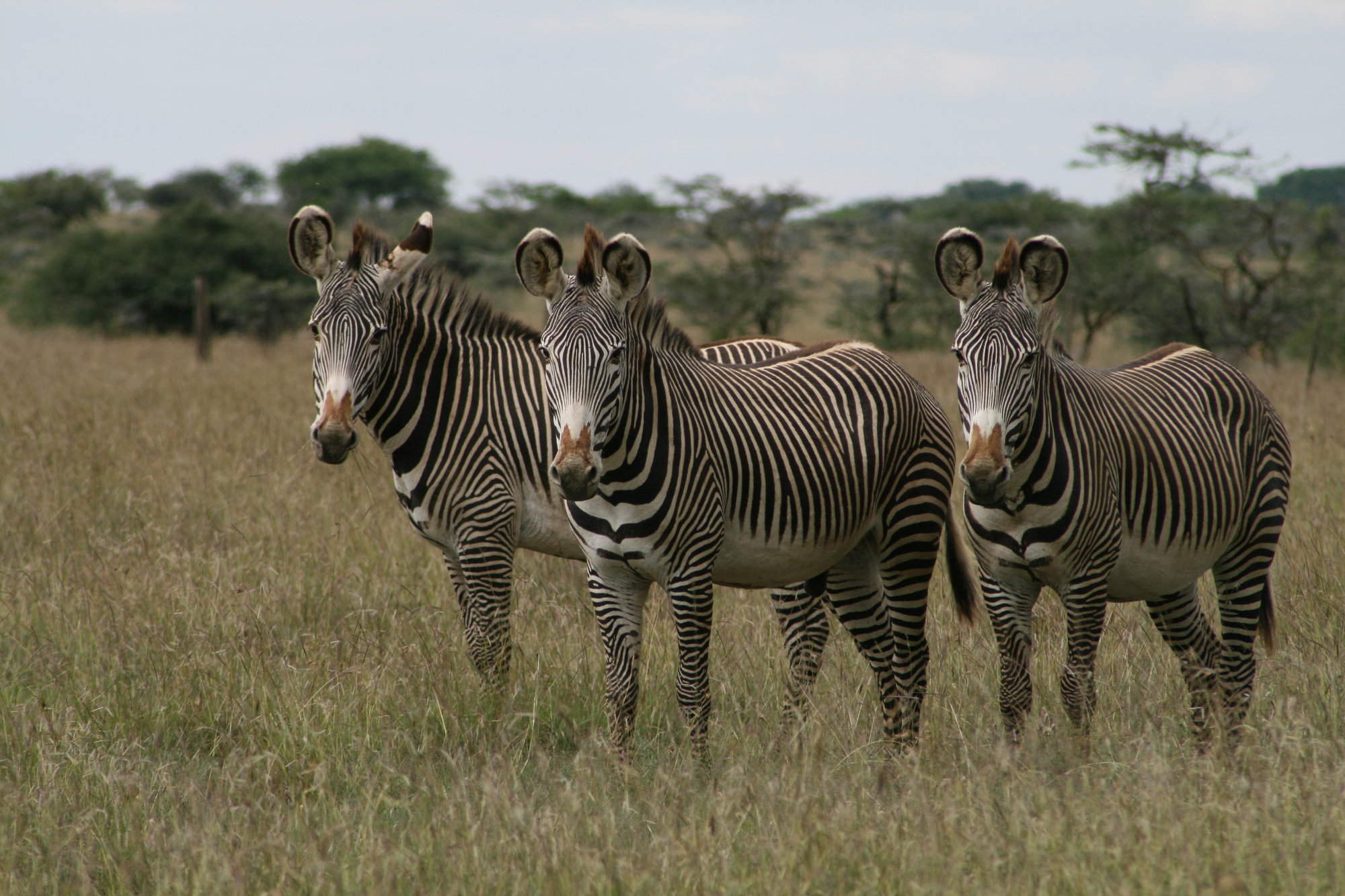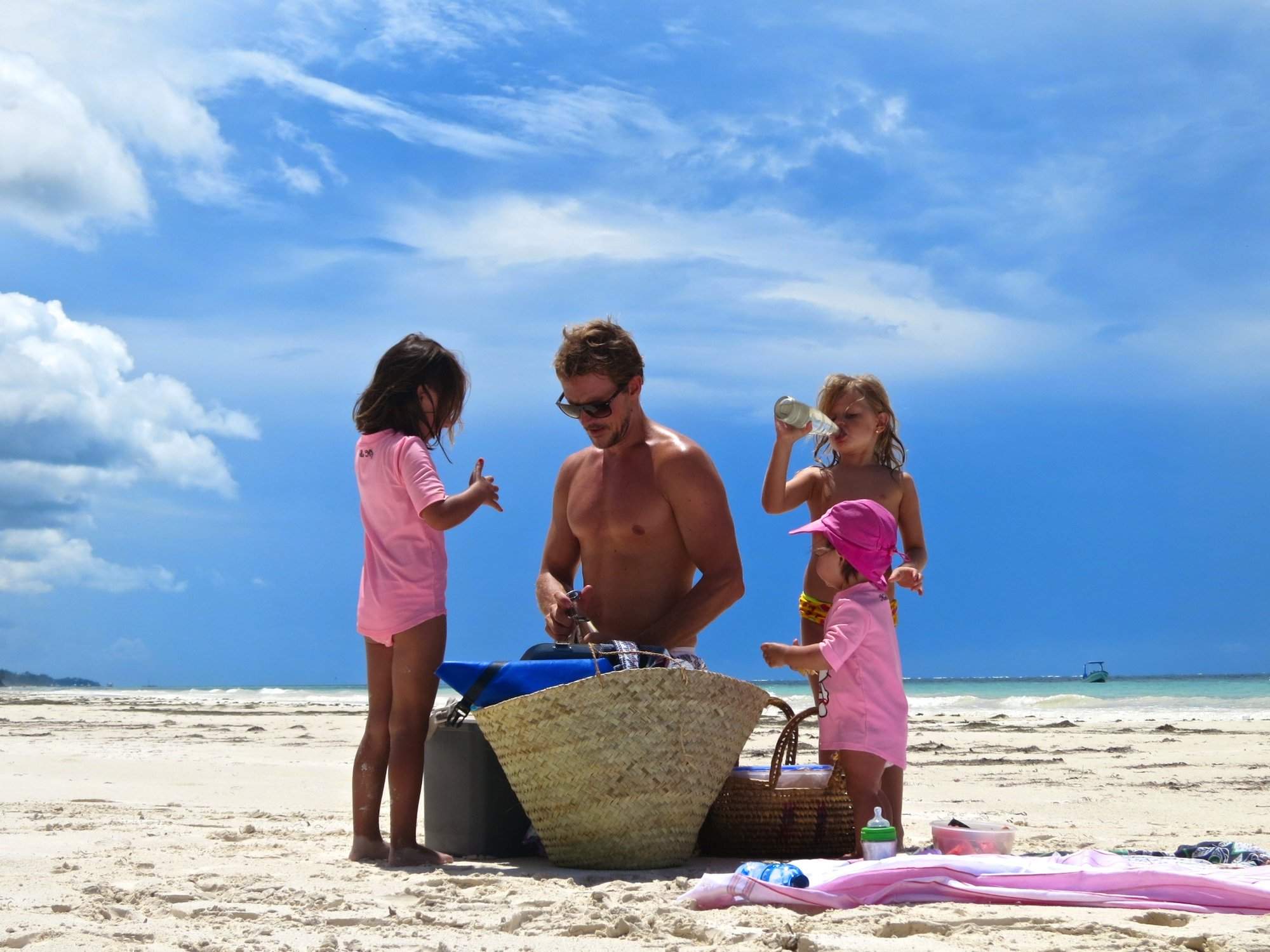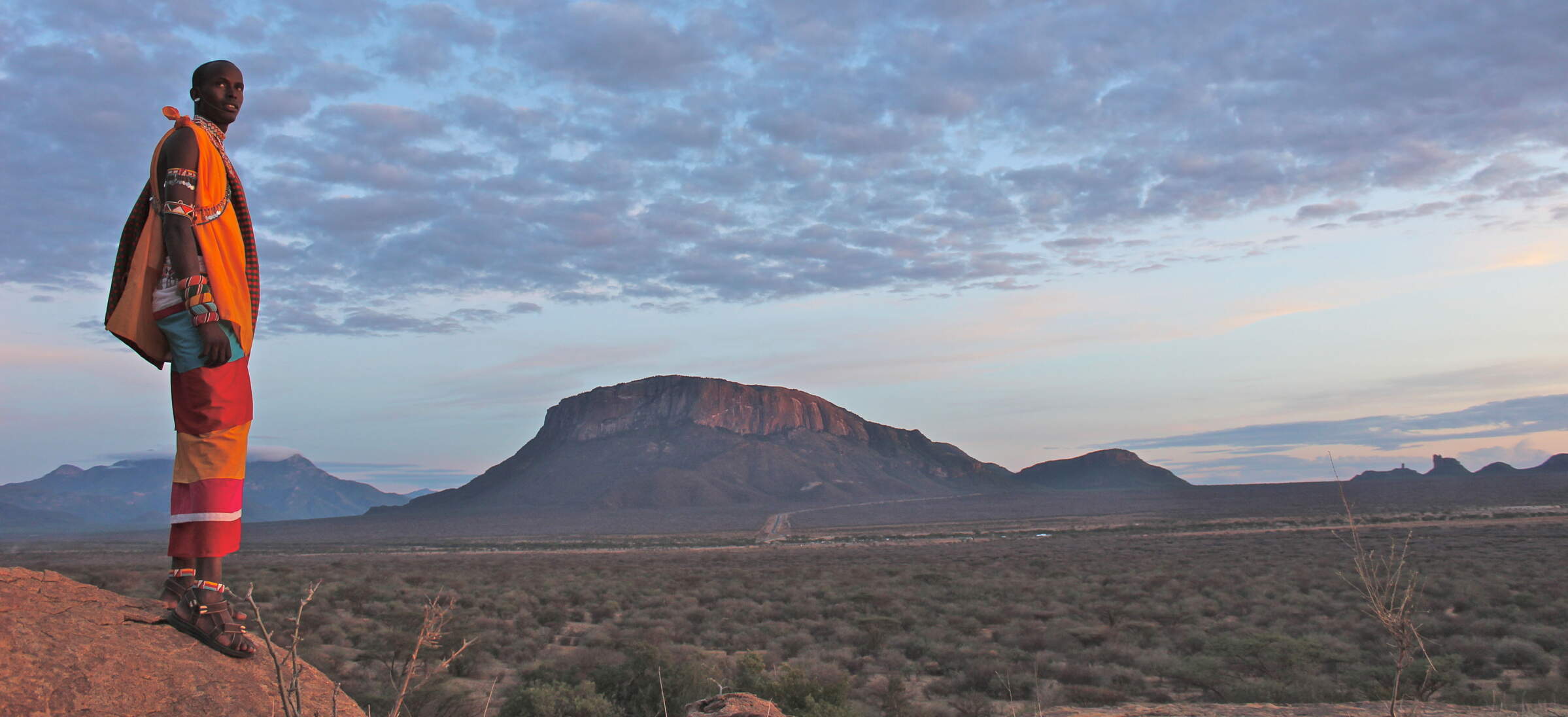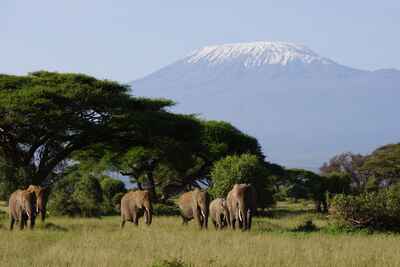
Amboseli's most famous icons are its elephants and the mass of Kilimanjaro.
The Chyulu Hills offer spectacular walks in the hilltop cloud forest.
Amboseli and the Chyulu Hills
Amboseli and the Chyulu Hills
Like an oasis in the dry savannah, with emerald-green swamps beneath towering Kilimanjaro, this is the best place in Africa to see elephants in dense concentrations.
Amboseli became a wildlife sanctuary in the 1940s and was declared a national park by Kenya’s first president, Jomo Kenyatta in 1974.
Although first impressions when you arrive at the airstrip can be of a bleak dust bowl, any doubts about the park are allayed by its magnificent elephant herds and high counts of other plains animals which converge to graze and drink at the park’s permanent swamps and lakes. The wildlife can often be viewed against the strikingly beautiful backdrop of Kilimanjaro, towering behind and offering scenes that are instantly recognisable. Although Amboseli has a wildebeest and zebra migration (like the Maasai Mara’s but on a very much smaller scale as they disperse across the ecosystem and into Tanzania), thousands of animals are resident here all year round.
The Amboseli region has several lodges and safari camps, from which Expert Africa has selected two of the most distinctive: Satao Elerai, in its own private conservancy close to the Tanzanian border and with dramatic views of Kilimanjaro; and Porini Amboseli Camp in the remote wilderness of Selenkay Conservancy, to the north of the park, where bush walks and uncrowded game-viewing are on offer.

Safaris visiting Amboseli & Chyulu Hills
Just ideas, we'll always tailor-make a trip for you

Black Kite Fly-in Safari
10 days • 4 locations
NAIROBI AIRPORT TO NAIROBI AIRPORT
Explore Kenya in-depth with visits to Nairobi and Meru national parks, the Mara Conservancies and Amboseli. Nestled in remoter regions, four camps provide fantastic access to rich game, a range of activities and beautifully diverse landscapes.
US$10,410 - US$14,150 per person

Gabar Goshawk Fly-in Safari
7 days • 3 locations
NAIROBI AIRPORT TO NAIROBI AIRPORT
Experience Amboseli and Laikipia during this economically priced safari. Two simple camps offer adventure before a stopover in Nairobi and a final stay in the charming, wildlife-rich Il Ngwesi Eco-Lodge.
US$6,580 - US$6,580 per person

Golden Weaver Fly-In Safari
6 days • 2 locations
NAIROBI AIRPORT TO NAIROBI AIRPORT
A rustic, adventurous week on safari with great community involvement that offers incredible value for money in two very different locations – the Amboseli and Maasai Mara ecosystems.
US$3,720 - US$3,720 per person
Most recent reviews of our safaris to Amboseli & Chyulu Hills
Click below to browse all 79 reviews from Amboseli and the Chyulu Hills. All from our travellers; all are in full & unedited.
Arrived 4 Mar 2025, 17 nights
"My Mar 2025 Kenyan Safari"
Overall rating: Excellent
Arrived 25 Feb 2025, 14 nights
"Kenya & Tanzania"
Overall rating: Excellent
Arrived 7 Feb 2025, 11 nights
"My Feb 2025 trip"
Overall rating: Excellent
Arrived 30 Jan 2025, 14 nights
"My Jan 2025 trip"
Overall rating: Excellent
Arrived 28 Jan 2025, 11 nights
"My Jan 2025 trip: Something undoubtedly to be repeated."
Overall rating: Excellent
Arrived 27 Jan 2025, 16 nights
"My Jan 2025 trip"
Overall rating: Excellent
Arrived 26 Jan 2025, 7 nights
"My Jan 2025 trip"
Overall rating: Good
Arrived 10 Jan 2025, 9 nights
"My Jan 2025 trip to Kenya"
Overall rating: Excellent
Arrived 9 Jan 2025, 18 nights
"My Jan 2025 trip"
Overall rating: Excellent
Arrived 7 Jan 2025, 17 nights
"My Jan 2025 trip to Kenya"
Overall rating: Excellent
Where to stay in Amboseli & Chyulu Hills
Our suggestions for safari camps in Amboseli and the Chyulu Hills
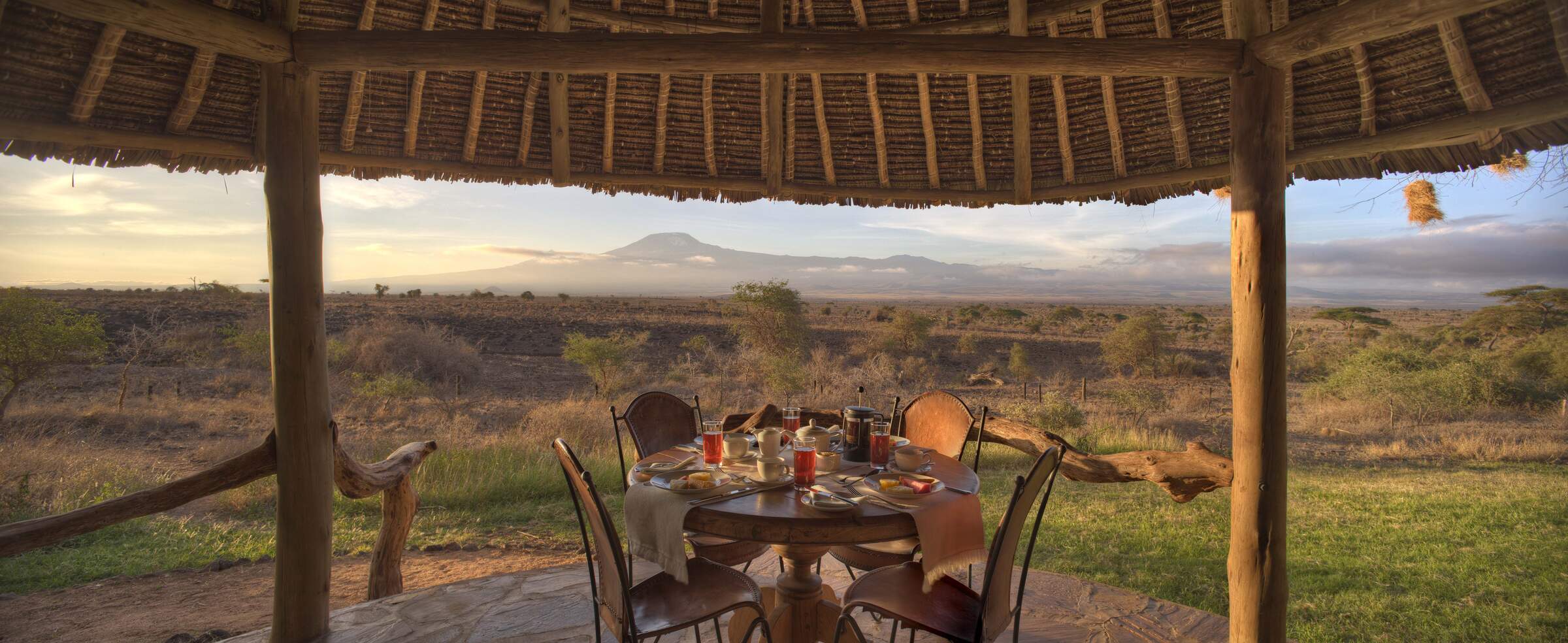
Tortilis Camp
Tortilis is a finely situated and well built safari camp located in the private Kitirua Consarvancy just outside Amboseli National Park and with wonderful views of Kilimanjaro.

Porini Amboseli Camp
Porini Amboseli is a small and homely community-staffed eco-camp located in the Selankay Conservancy.

Tawi Lodge
Tawi Lodge is modern, luxury safari lodge on a private wildlife conservancy in the Amboseli ecosystem in southern Kenya.

Satao Elerai
The closest camp in Kenya to Mount Kilimanjaro, Satao Elerai is located in its own, private conservancy, the Elerai Conservation Area, just outside Amboseli National Park.

Selenkay Adventure
Selenkay Adventure Camp is the dome-tent satellite camp of Porini Amboseli Camp, located in the Maasai-owned Selenkay Conservancy, one of the oldest community wildlife conservancies in Kenya.

Campi ya Kanzi
Campi ya Kanzi is a very well integrated, eco-friendly bush lodge and tented camp on the slopes of the Chyulu Hills in its own, 1000-square-kilometre Maasai conservancy.

Ol Donyo Lodge
Ol Donyo is a luxurious and innovative designer safari lodge with magnificent views and excellent walking, riding and wildlife country in its own private conservancy.

Angama Amboseli
Angama Amboseli is a luxury safari camp in the long-established Kimana Conservancy, about a 45-minute drive east of Amboseli National Park.
Our travellers’ wildlife sightings in Amboseli & Chyulu Hills
This is their success for sightings in Amboseli and the Chyulu Hills. Click on a species for more detail. How we work this out.

100% success

100% success

98% success

98% success

95% success

94% success

84% success

82% success

61% success

50% success

45% success

34% success

20% success

10% success

6% success

6% success

4% success

0% success
When to go to Amboseli and the Chyulu Hills
Our month by month guide: What it's like to visit Amboseli & Chyulu Hills in Kenya
Jan
Feb
Mar
Apr
May
Jun
Jul
Aug
Sep
Oct
Nov
Dec
Kenya in January
Clear, hot days and warm nights make this high season a popular time for safaris and it’s also good for diving and snorkelling as water clarity is excellent and gets better as the dry season progresses. Most lodges and tented camps treat January after the New Year week is over, as mid-season, making it a good compromise in terms of value for money with reasonably reliable, dry weather and some greenery left in the landscape.
Expert Africa bases its description of climate and weather in January, like the other months of the year, on the climate records of roughly the last 100 years, and it's fair to say that the weather and seasons since the beginning of this century have been highly irregular and unpredictable.
- On average, January is the second driest month of the year
- Elephants dig waterholes in the dry riverbed in the Samburu reserve.
- Wildebeest and many antelope have their calving season, to February.
- Migrant birds are seen in huge numbers, especially in the Rift Valley.
- Sea water clarity around the coral reefs generally good.
Our view
Fantastic: the very best time to visit
Weather in January
Kenya in February
With the short dry season well established, the grass grazed down and wildlife gathering close to water points, this is still a good time for a safari. Good water clarity in the Indian Ocean's coastal waters makes for excellent diving and snorkelling conditions.
Expert Africa bases its description of climate and weather in February, like the other months of the year, on the climate records of roughly the last 100 years, and it's fair to say that the weather and seasons since the beginning of this century have been highly irregular and unpredictable.
- On average, February is the driest month of the year.
- It’s sometimes possible to swim with whale sharks at Diani Beach.
- Migrant birds are still seen everywhere, especially near water.
- This is usually peak calving season for wildebeest and many antelopes.
- This month is often the hottest of the year, especially on the coast.
Our view
A very good time to visit
Weather in February
Kenya in March
Hot, increasingly humid weather – with good diving and snorkelling conditions at the start of the month – gives way to rains and lower accommodation costs. Expert Africa bases its description of climate and weather in March, like the other months of the year, on the climate records of roughly the last 100 years, and predicting the seasons since the beginning of this century has been difficult.
March is the month when – traditionally – intensely hot conditions build up until a cloudburst finally happens at the end of the month or in early April, to relieve the humidity. As ever, regional variations across the country can greatly impact on visitors' experiences.
- Sea-water clarity is best for diving before the long rains start.
- Visitor numbers are low, though the Easter holidays can be busier.
- Night skies can be scintillatingly clear in early March.
- Cropped down savannah grasses can make it easier to see the wildlife.
- Temperartures climb high, especially at lower elevations.
Our view
A good time to visit, with pros & cons
Weather in March
Kenya in April
April sees the full onset of the southeast monsoon wind or kusi, which heralds the long rains. Temperatures drop soon after the rains are established and you’ll often have facilities largely to yourself in this more affordable low season, sometimes known as the "green season". The bush quickly springs to life, with greenery sprouting almost before your eyes. While you're likely to get a fair number of heavy showers, the breaks in the rain can yield sparklingly clear conditions.
With the dust settled and bright sun piercing the clouds, conditions can be sublime for photography, especially first thing in the morning or in the late afternoon with another storm brewing. You may be lucky, or you may find conditions very wet and muddy.
- A wet month, the coast often gets more than 300mm (12in) of rain.
- Sunny spells can provide great light for photography.
- Buffalo and zebra calving season often happens in this month.
- Baby crocodiles hatch, for example on Central Island in Lake Turkana.
- Palearctic migrant birds gather to fly north to breeding grounds.
Our view
A time to avoid if possible
Weather in April
Kenya in May
While game viewing can be trickier as vegetation runs riot, between the cloudbursts the colours and light are great for photography at this time of year. Expert Africa bases its description of climate and weather in May, like the other months of the year, on the climate records of roughly the last 100 years, and while it's reasonable to expect heavy rains in many parts during this month, especially on the coast, the rains don't always come evenly or in some areas come at all.
In an El Niño year, the so-called long rains that normally are established across much of the country by May can be meagre, to the despair of farmers. On the other hand in a La Niña year, the long rains can bring floods. On the coast, the monsoon winds make the climate much more predictable, with heavy rains common throughout this month.
- Frogs breed in the ponds in the Arabuko Sokoke Forest near Watamu.
- Wildebeest, impala and other grazers are in rut (the breeding season).
- Kilimanjaro looks its best as heavy rain falls as snow on the summit.
- There's a sharp peek of rainfall on the coast with many rainy days.
- Accommodation prices are uniformly low, while some camps close.
Our view
A time to avoid if possible
Weather in May
Kenya in June
The rains give way to cloudy, cooler weather, often making for comfortable conditions by the end of the month, especially in the highlands. Starting from mid-June or the beginning of July and running until the end of October, this is the high season, and accordingly has higher accommodation rates and – at least until early September – higher numbers of visitors.
While the early part of June can often be rainy on the coast, it can be a great time to go on safari, with fresh greenery, many young animals and good photographic conditions with clear air.
- The Taru Desert, inland from the coast, is carpeted with flowers.
- The Lake Turkana Cultural Festival is held in Loiyangalani.
- Madaraka Day (commemorating self rule) is 1 June.
- The annual Lewa marathon runs a course through the wildlife.
- The Diani Rules "sports" event rips up the rulebook at Diani Beach.
Our view
A good time to visit, with pros & cons
Weather in June
Kenya in July
Kenya’s “winter" season sets in (winter is a misnomer but locals feel the change), and the highlands can be rather grey. Skies are often cloudy and the days can be surprisingly cool, with an average daytime high in many highland safari areas of 15-20°C and night-time temperatures dropping below 10°C in Nairobi and the highlands. Lower parts of the country and the coast are usually warm and dry, typically reaching highs of around 25°C with lows in the high teens.
As this is the start of the high season, coinciding with the usual arrival of the wildebeest migration in the Maasai Mara, July is a busy month. Ask your Expert Africa specialist to advise on how to avoid the crowds, which is not that difficult to do.
- The wildebeest migration usually reaches the Maasai Mara in July.
- Simbi Lake (Kisumu) and Crater Lake (Naivasha) can attract flamingoes.
- Watersports start to pick up and some surfing is possible at Malindi.
- Afternoon thunderstorms are a common feature in the Maasai Mara.
- The sea can be choppy along the coast, making diving difficult.
Our view
A good time to visit, with pros & cons
Weather in July
Kenya in August
The Great Migration fills the plains of the Maasai Mara, and school’s out, so the park roads are full of tourists – ask your Expert Africa specialist for advice on crowd avoidance tactics. Choose a private conservancy rather than a public national park or national reserve for quieter conditions.
Like July, August is generally mild and relatively dry in the safari areas, but it can be very chilly in the highlands, even in the middle of the day, and hail occasionally falls above altitudes of around 2,400m (8,000ft). Nairobi can be disappointingly overcast, with low cloud.
- Apart from Christmas holidays, this is the busiest month of the year.
- Late August sees peak wildebeest drama at the Mara River crossings.
- Coastal winds are good for kite- and wind-surfing.
- Few mosquitoes are around at this generally dry time of year.
- The annual Camel Derby takes place in the Samburu capital, Maralal.
Our view
A good time to visit, with pros & cons
Weather in August
Kenya in September
The skies clearing of cloud signals the start of hot, dry weather with little chance of rain – and, after the first few days of the month, far fewer visitors – making the latter part of September a good time for a quieter safari. While early September is often good for dramatic migration crossings along the Mara River, you might consider deliberately postponing your trip until later in the month, when the migration can still be very impressive and visitor numbers fewer.
If tourist surges are somewhat predictable, however, the patterns of the wildebeest migration are more volatile, and like all of Expert Africa's climate and weather assessments, they are based on accumulated years of experience rather than guaranteed certainty.
- This is still high season, with prices to match.
- Many river crossings take place on the Mara river in both directions.
- Natural bush fires flush out insects and small animals for predators.
- The Rift Valley Music Festival takes place by Lake Naivasha.
- With school holidays over by early September, late-month is quieter.
Our view
Fantastic: the very best time to visit
Weather in September
Kenya in October
Still hot, mostly dry and not too busy, this is many people’s preferred month for a safari, and it’s also good for diving and snorkelling. The wildebeest and zebra herds of the great migration are often still to be seen, though in dwindling numbers. The swamps of Amboseli attract thirsty wildlife including large herds of elephants.
While we wouldn't expect much rain across most of the country this month, the climate has become so unpredictable that you can never say never, and the possibiity of the short rains – usually associated with November to mid-December, starting early, can't be discounted.
- This month sees the tail end of the great migration in the Mara.
- Palearctic migrant birds start to arrive, staying until March.
- Turtle nests hatch at Watamu, until November.
- Amboseli elephants focus on the swamps for their daily water.
- The Indian Ocean monsoon winds turn from southeast to northeast.
Our view
A very good time to visit
Weather in October
Kenya in November
The northeast monsoon wind or kaskazi heralds the start of the “short rains", usually some time in the second half of the month. From November to mid-December, this is the low season, and accordingly has lower accommodation rates and lower visitor numbers. Across most of the country you can expect warm, somewhat cloudy weather, with occasional heavy showers and localised flooding.
Expert Africa bases its description of the climate in November, like the other months of the year, on the records of roughly the last 100 years, and it's fair to say that the seasons since the beginning of this century have been highly irregular and unpredictable: some years the short rains don't come at all, or don't reach every part of the country. In an El Niño year, the November short rains can be very heavy, but in a La Niña year, they can fail completely.
- Swimming with dolphins in Lamu can be done from now until April.
- Birders gather at Ngulia in Tsavo West to ring Palearctic migrants.
- The Lamu Cultural Festival takes over the town and Lamu Creek.
- Agricultural shows often take place regional market towns.
- This is low season, so camps can be great value, with special offers.
Our view
A good time to visit, with pros & cons
Weather in November
Kenya in December
In a typical December, the rains usually finish by middle of the month, leaving the landscape looking its best, under clear blue skies, and heralding the start of the second peak tourist season from around 20 December to the first week of January. Our assessment of the likely weather in December, like the other months of the year, is based on climate records, and it's fair to say that the seasons since the beginning of this century have been highly irregular and unpredictable.
Christmas can sometimes be wet, but most years the rains have finished a week or two earlier, with the festive season ushering in the perfect combination of clear skies and sunshine by day and starry nights.
- Christmas and New Year are busy, with the lodges and camps full.
- Rates are highest after 24 Dec, with supplements on public holidays.
- Republic Day and Independence day are celebrated on 12 December.
- Good kite- and wind-surfing restarts, with strong northeasterly winds.
- Mango season begins, providing excitement for primates and elephants.
Our view
A good time to visit, with pros & cons
Weather in December
Amboseli and the Chyulu Hills: In Detail
Amboseli and the Chyulu Hills
The Amboseli wetlands are the dominant features of the park, with the Enkongo Narok swamp and its central feature, Lake Kioko, the main focus in the western part of the park, and the Longinye Swamp the big wildife magnet in the east. These permanent swamps are fed by meltwater from the peaks of Kilimanjaro, which soaks into the volcanic rock and springs up from the plains all year round. After the rains, a carpet of pasture fills the plains in between, but for much of the year the swamps with their sedges, waterlilies and papyrus provide a brilliant contrast with the dry plains. Much of the park’s vegetation is low, but to the south of the wetland areas, towards Kilimanjaro, there’s more woodland, with yellow-barked acacia and several other species of trees providing browsing for hundreds of Maasai giraffe and cover for hunting lion and cheetah.
Kilimanjaro
Landmarks and divisions of the Amboseli ecosystem
Looking northwest, the flat, dusty plain is ‘Lake Amboseli’ – a very occasionally rain-filled zone that occupies the northwest corner of the park. Some 5km to the east, the human ‘reserve’ of Ol Tukai, in the centre of the park, is the fenced location of Amboseli’s park headquarters, the big Ol Tukai Lodge, and the currently mothballed Amboseli Lodge. If you’re in need of a comfort break, a cold drink or another leg stretch, drivers will often pause a game drive to take a break here.
The Amboseli region’s artificial divisions start with the Amboseli National Park itself. Bordering the park to the west is the Kitirua Game Conservancy, with the luxury Tortilis Camp. A fair way north of the park, commonly accessed by road transfer from Amboseli airstrip, lies the quite remote Selenkay Conservancy, location of Porini Amboseli Camp. On the southeast side of the park, closer to Kilimanjaro than anywhere else in the region, lies Elerai Conservancy and Satao Elerai Camp.
Selenkay Conservancy
Kitirua Conservancy
Chyulu Hills National Park
The crest of the hills is another world, partly swathed in mossy cloud forest, where giant forest hogs barge through the undergrowth watched by goggle-eyed chameleons and spectacularly large, silvery-cheeked hornbills. Other highland forest birds that can be encountered here include the Abyssinian crimsonwing and a partly terrestrial pigeon – the lemon or cinnamon dove.
Wildlife of Amboseli National Park
With a few years of tolerance from the local communities, the Amboseli predators, with their relatively quick generational cycles, have made a rapid comeback, and our recent visits have revealed good sightings of lions and hyenas, although cheetah have proved more elusive.
Bird counts in Amboseli can be astonishing: there are reckoned to be as many as 400 species present in this small park, including native rarities like the Madagascar squacco heron and the Taveta golden weaver (relatively common at camps and lodges around the park) as well as Palearctic migrants such as the Caspian plover. The water birds are the highlights, and in many areas the park’s tracks follow close to the water’s edge, allowing you great sightings of specialities like the long-toed lapwing and rufous-bellied heron – if you can take your eyes of the elephants in the swamp.
Amboseli’s elephants
The elephants of Amboseli have been the focus of a long research project run by the Amboseli Trust for Elephants. Founded in 1975 by Cynthia Moss, who had met elephant researcher Iain Douglas-Hamilton in Tanzania a few years earlier, the trust has become one of the most important elephant research centres in the world. It was here that elephants’ infrasonic communications (‘tummy rumbles’) were first recorded and studied and where the true complexity of their social structures and inter-personal relationships, and the sophistication of their cognitive abilities, were revealed.
History of the Amboseli region
The first European visitor in the Amboseli region was the Scottish explorer Joseph Thomson, who walked through in 1883. The remarkably sensitive travels of the young Thomson (he was aged just 25) covered a huge portion of southern Kenya as far west as Lake Victoria, with his 150-strong column. It was always claimed that nobody had ever lost their life on a Thomson safari, unlike the violent behaviour of so many of those who followed the trails he blazed. Although a German missionary, Johann Rebmann, had given an account of snow-capped Kilimanjaro in 1848, Thomson was the first person to provide a written record of what was then known as the Njiri Plain. On the northwest side he found Lake Amboseli entirely dry – its usual state even today – with mineral salts encrusting its surface and shimmering in the heat.
The Southern Maasai Reserve, a vast region stretching from Nairobi to Kilimanjaro and west to the Mara River, was created in 1899 in an attempt to confine the nomadic Maasai to a region that wasn’t of interest to colonial settlers intent on farming. In 1948, the colonial government established the Amboseli Reserve, this time focusing more on the wildlife, but acknowledging the rights of Maasai pastoralists to graze and water their herds in this important wetland. The region came under Maasai control through Kajiado District Council in 1961, but encroachment, booming population and a rise in tourism prompted President Jomo Kenyatta to withdraw local control and put the area in the hands of the National Parks service in 1974. As a result, Amboseli National Park became a total exclusion zone for the Maasai community, who were evicted and prevented from using the swamps to water their cattle. Ironically, far from protecting the wildlife, the relatively small new national park (just 400km²) so enraged the local community that first the area’s magnificent, long-horned black rhinos and then most of its lions were wiped out as the excluded herders retaliated with spears.
Amboseli has been a high-profile bellwether for human-wildlife relations in Kenya ever since, although the balance is much healthier these days as local communities increasingly recognise the value of the wildlife ‘resource’ in attracting tourists and bringing them an income. This is particularly important where the Maasai are involved directly through leasing their own land as community conservancies around the fringes of the national park to safari operators and taking jobs at safari camps.
Map of Amboseli and the Chyulu Hills
Choices for where to stay in Amboseli and the Chyulu Hills

Amboseli and the Chyulu Hills: Safaris
Our wildlife safari holidays in the Amboseli National Park area of southern Kenya include stays at two quite different camps in the region. At the luxury Tortilis camp, when you're not watching the wildlife in the camp's private conservancy, you can cool off in one of their two swimming pools beneath Kilimanjaro. At Porini Amboseli Camp you will be hosted, looked after and guided by the gentle warriors of the Selenkay Maasai community. Their conservancy is owned and managed by local people and you'll be able to visit a nearby village as well as have fantastic wildlife viewing, including elephants, big cats and giraffes.

Black Kite Fly-in Safari
10 days • 4 locations
NAIROBI AIRPORT TO NAIROBI AIRPORT
Explore Kenya in-depth with visits to Nairobi and Meru national parks, the Mara Conservancies and Amboseli. Nestled in remoter regions, four camps provide fantastic access to rich game, a range of activities and beautifully diverse landscapes.
US$10,410 - US$14,150 per person

Gabar Goshawk Fly-in Safari
7 days • 3 locations
NAIROBI AIRPORT TO NAIROBI AIRPORT
Experience Amboseli and Laikipia during this economically priced safari. Two simple camps offer adventure before a stopover in Nairobi and a final stay in the charming, wildlife-rich Il Ngwesi Eco-Lodge.
US$6,580 - US$6,580 per person

Golden Weaver Fly-In Safari
6 days • 2 locations
NAIROBI AIRPORT TO NAIROBI AIRPORT
A rustic, adventurous week on safari with great community involvement that offers incredible value for money in two very different locations – the Amboseli and Maasai Mara ecosystems.
US$3,720 - US$3,720 per person
Best 8 lodges and safari camps in Amboseli and the Chyulu Hills
There are two reliable lodges and a luxury tented camp effectively inside the park, while a clutch of camps and lodges has sprung up just outside the park. Listed below are our recommendations for the best places to stay. Ask us for more details of what's where, and what's likely to suit you best!

Tortilis Camp
Tortilis is a finely situated and well built safari camp located in the private Kitirua Consarvancy just outside Amboseli National Park and with wonderful views of Kilimanjaro.

Porini Amboseli Camp
Porini Amboseli is a small and homely community-staffed eco-camp located in the Selankay Conservancy.

Tawi Lodge
Tawi Lodge is modern, luxury safari lodge on a private wildlife conservancy in the Amboseli ecosystem in southern Kenya.

Satao Elerai
The closest camp in Kenya to Mount Kilimanjaro, Satao Elerai is located in its own, private conservancy, the Elerai Conservation Area, just outside Amboseli National Park.

Selenkay Adventure
Selenkay Adventure Camp is the dome-tent satellite camp of Porini Amboseli Camp, located in the Maasai-owned Selenkay Conservancy, one of the oldest community wildlife conservancies in Kenya.

Campi ya Kanzi
Campi ya Kanzi is a very well integrated, eco-friendly bush lodge and tented camp on the slopes of the Chyulu Hills in its own, 1000-square-kilometre Maasai conservancy.

Ol Donyo Lodge
Ol Donyo is a luxurious and innovative designer safari lodge with magnificent views and excellent walking, riding and wildlife country in its own private conservancy.

Angama Amboseli
Angama Amboseli is a luxury safari camp in the long-established Kimana Conservancy, about a 45-minute drive east of Amboseli National Park.

Looking for inspiration on where to travel next?
Visit our trip chooser to explore your options and find inspiration for your perfect African adventure
Inspire me

